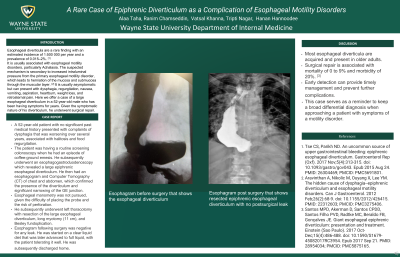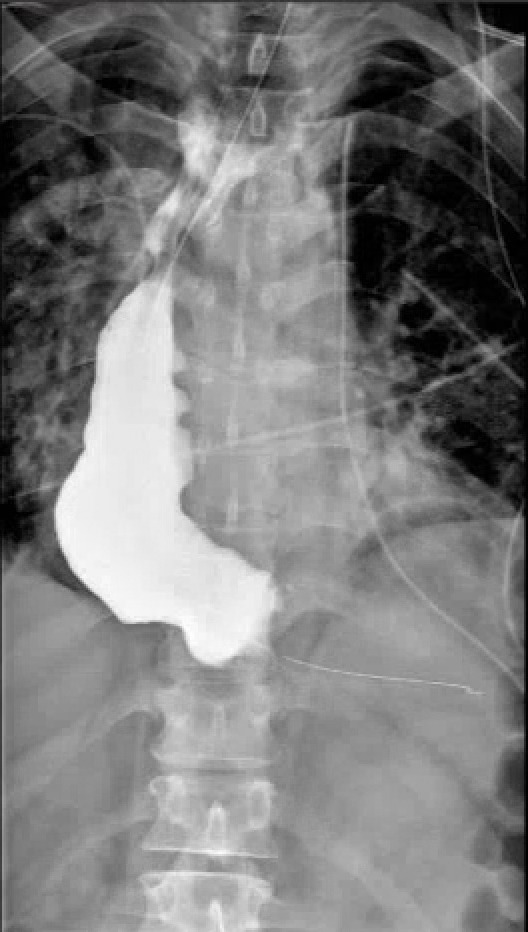Back


Poster Session B - Monday Morning
Category: Esophagus
B0233 - A Rare Case of Epiphrenic Diverticulum as a Complication of Esophageal Motility Disorders
Monday, October 24, 2022
10:00 AM – 12:00 PM ET
Location: Crown Ballroom

Has Audio
.jpg)
Alaa Taha, MD
Wayne State University School of Medicine
Rochester, MI
Presenting Author(s)
Alaa Taha, MD1, Ranim Chamseddin, MD2, Vatsal Khanna, MD2, Tripti Nagar, MD2, Hanan Hannoodee, MD2
1Wayne State University School of Medicine, Rochester, MI; 2Wayne State University, Rochester, MI
Introduction: Esophageal diverticula are a rare finding with an estimated incidence of 1:500 000 per year and a prevalence of 0.015–2%. It is usually associated with esophageal motility disorders, particularly Achalasia. The suspected mechanism is secondary to increased intraluminal pressure from the primary esophageal motility disorder, which leads to herniation of the mucosa and submucosa through the muscular layer. It is usually asymptomatic but can present with dysphagia, regurgitation, nausea, vomiting, aspiration, heartburn, weight loss, and retrosternal pain. Here we offer a case of a large esophageal diverticulum in a 52-year-old male who has been having symptoms for years. Given the symptomatic nature of his diverticulum, he underwent surgical repair.
Case Description/Methods: A 52-year-old patient with no significant past medical history presented with complaints of dysphagia that was worsening over several years, associated with halitosis and food regurgitation. The patient was having a routine screening colonoscopy when he had an episode of coffee-ground emesis. He subsequently underwent an esophagogastroduodenoscopy which revealed a large epiphrenic esophageal diverticulum. He then had an esophagogram and Computer Tomography (CT) of chest and abdomen, which confirmed the presence of the diverticulum and significant narrowing of the GE junction. Esophageal manometry was not pursued, given the difficulty of placing the probe and the risk of perforation. He subsequently underwent left thoracotomy with resection of the large esophageal diverticulum, long myotomy (11 cm), and Besley fundoplication. Esophagram following surgery was negative for any leak. He was started on a clear liquid diet that was later advanced to full liquid, with the patient tolerating it well. He was subsequently discharged home.
Discussion: Esophageal diverticula are rare findings with an estimated incidence of 1:500 000 per year and a prevalence of 0.015–2%. Most esophageal diverticula are acquired and present in older adults. Surgical repair is associated with mortality of 0 to 9% and morbidity of 20%. This case serves as a reminder to keep a broad differential diagnosis when approaching a patient with symptoms of a motility disorder. Early detection can provide timely management and prevent further complications.

Disclosures:
Alaa Taha, MD1, Ranim Chamseddin, MD2, Vatsal Khanna, MD2, Tripti Nagar, MD2, Hanan Hannoodee, MD2. B0233 - A Rare Case of Epiphrenic Diverticulum as a Complication of Esophageal Motility Disorders, ACG 2022 Annual Scientific Meeting Abstracts. Charlotte, NC: American College of Gastroenterology.
1Wayne State University School of Medicine, Rochester, MI; 2Wayne State University, Rochester, MI
Introduction: Esophageal diverticula are a rare finding with an estimated incidence of 1:500 000 per year and a prevalence of 0.015–2%. It is usually associated with esophageal motility disorders, particularly Achalasia. The suspected mechanism is secondary to increased intraluminal pressure from the primary esophageal motility disorder, which leads to herniation of the mucosa and submucosa through the muscular layer. It is usually asymptomatic but can present with dysphagia, regurgitation, nausea, vomiting, aspiration, heartburn, weight loss, and retrosternal pain. Here we offer a case of a large esophageal diverticulum in a 52-year-old male who has been having symptoms for years. Given the symptomatic nature of his diverticulum, he underwent surgical repair.
Case Description/Methods: A 52-year-old patient with no significant past medical history presented with complaints of dysphagia that was worsening over several years, associated with halitosis and food regurgitation. The patient was having a routine screening colonoscopy when he had an episode of coffee-ground emesis. He subsequently underwent an esophagogastroduodenoscopy which revealed a large epiphrenic esophageal diverticulum. He then had an esophagogram and Computer Tomography (CT) of chest and abdomen, which confirmed the presence of the diverticulum and significant narrowing of the GE junction. Esophageal manometry was not pursued, given the difficulty of placing the probe and the risk of perforation. He subsequently underwent left thoracotomy with resection of the large esophageal diverticulum, long myotomy (11 cm), and Besley fundoplication. Esophagram following surgery was negative for any leak. He was started on a clear liquid diet that was later advanced to full liquid, with the patient tolerating it well. He was subsequently discharged home.
Discussion: Esophageal diverticula are rare findings with an estimated incidence of 1:500 000 per year and a prevalence of 0.015–2%. Most esophageal diverticula are acquired and present in older adults. Surgical repair is associated with mortality of 0 to 9% and morbidity of 20%. This case serves as a reminder to keep a broad differential diagnosis when approaching a patient with symptoms of a motility disorder. Early detection can provide timely management and prevent further complications.

Figure: Esophagram after surgical repair of epiphrenic esophageal diverticulum
Disclosures:
Alaa Taha indicated no relevant financial relationships.
Ranim Chamseddin indicated no relevant financial relationships.
Vatsal Khanna indicated no relevant financial relationships.
Tripti Nagar indicated no relevant financial relationships.
Hanan Hannoodee indicated no relevant financial relationships.
Alaa Taha, MD1, Ranim Chamseddin, MD2, Vatsal Khanna, MD2, Tripti Nagar, MD2, Hanan Hannoodee, MD2. B0233 - A Rare Case of Epiphrenic Diverticulum as a Complication of Esophageal Motility Disorders, ACG 2022 Annual Scientific Meeting Abstracts. Charlotte, NC: American College of Gastroenterology.
